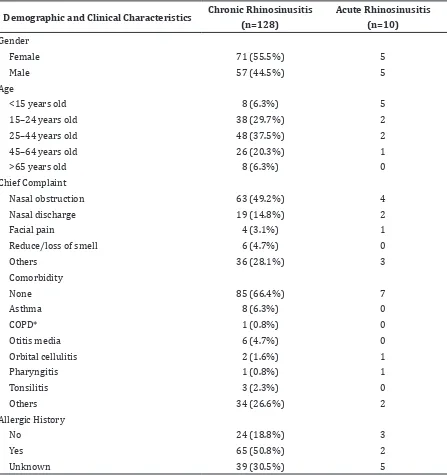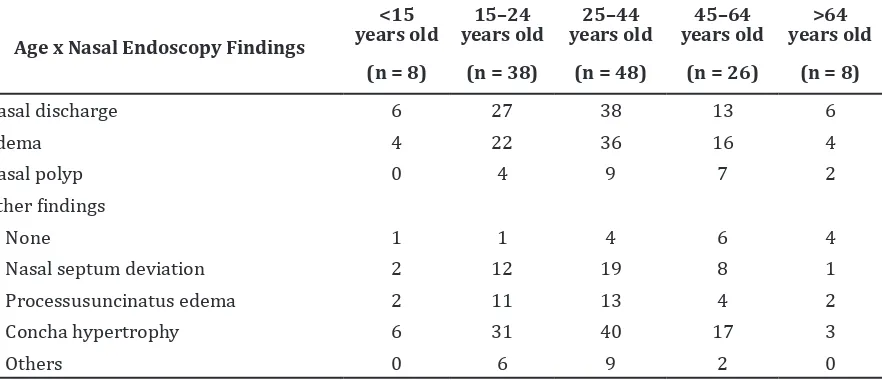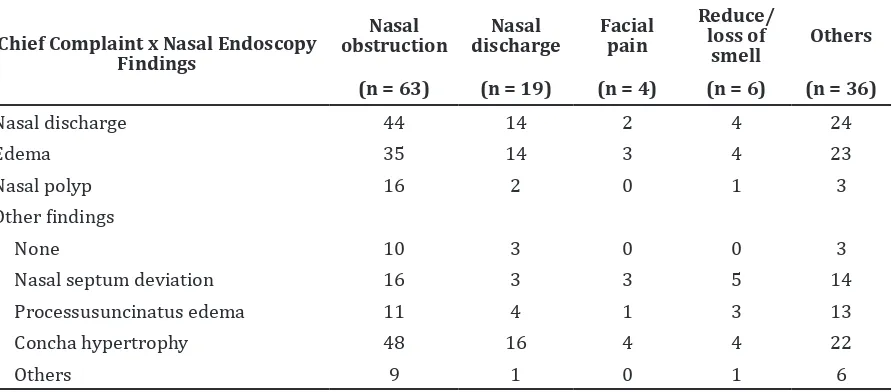Nasal Endoscopy Findings in Acute and Chronic Rhinosinusitis Patients
Stephanie Dharmaputri,1 Lina Lasminingrum,2 Yulia Sofiatin3
1Faculty of Medicine Universitas Padjadjaran, 2Department of Otorhinolaryngology–Head and
Neck Surgery Faculty of Medicine Universitas Padjadjaran/Dr. Hasan Sadikin General Hospital Bandung, 3Department of Public Health Faculty of Medicine Universitas Padjadjaran
Abstract
Background: According to European Position Paper on Rhinosinusitis and Nasal Polyps (EPOS) 2012, rhinosinusitis is diagnosed based on symptoms, nasal endoscopy, and CT scan. The CT scan is the gold standard to diagnose rhinosinusitis, but its high cost and lack of availability become the problems in Indonesia. Hence, nasal endoscopy is a choice to diagnose rhinosinusitis. This study was aimed to describe the findings of nasal endoscopyin in acute and chronic rhinosinusitis.
Methods: This cross-sectional descriptive study was performed using medical record of acute and chronic rhinosinusitis patients. The samples were chosen with consecutive sampling. Inclusion criteria of this study were patients that underwent nasal endoscopy examination in Otorhinolaryngology–Head and Neck Surgery Clinic Dr. Hasan Sadikin General Hospital Bandung in 2014.The collected data were analyzed in the form of tables.
Results: Among 138 patients, the number of female patients (55.1%) was higher than male patients. Majority of the patients (37.5%) were 25–44 years old. Majority of the chief complaint was nasal obstruction (48.6%). The patients with allergic history (48.6%) were higher than patients without allergic history (19.6%). According to nasal endoscopy results, nasal discharge and edema were found in most of the patients (68.8% and 63.0%), but nasal polyp was only found in 15.9% patients. Other findings, such as hypertrophy concha or nasal septum deviation, were also found on 87.7% patients.
Conclusions: Most of the rhinosinusitis patients are found with at least one of the following results of nasal endoscopy, which are nasal discharge, edema, or nasal polyp.
Keywords: Nasal discharge, nasal endoscopy, nasal obstruction, rhinosinusitis.
Correspondence: Stephanie Dharmaputri, Faculty of Medicine, Universitas Padjadjaran, Jalan Raya Bandung-Sumedang Km.21, Jatinangor, Sumedang, Indonesia, Email: stephaniedharmaputri@gmail.com
Introduction
Rhinosinusitis, an inflammation of the nose and the paranasal sinuses, is a significant health problem.Its incidence and prevalence are growing thus increase the treatment challenge for the clinician.1–3 According to European Position Paper on Rhinosinusitis and Nasal Polyps (EPOS) 2012, diagnosis of rhinosinusitis is enforced based on symptoms, nasal endoscopy, and computed tomography (CT). The symptoms are either nasal obstruction or nasal discharge, with or without facial pain and with or without reduction or loss of smell. Nasal endoscopy that discovers nasal polyp and/or mucopurulent discharge and/or edema, primarily from middle meatus, and/or result of CT scan that findsmucosal changes within the osteomeatal complex
and/or sinuses are results of additional examination that are referred to diagnosis of rhinosinusitis.4
The CT scan is the gold standard for diagnosis of rhinosinusitis, but its high cost and lack of availability become the problems in Indonesia.2,5 Hence, nasal endoscopy becomes the choice for diagnosing rhinosinusitis. Many studies also found that nasal endoscopy is suitable for diagnosing rhinosinusitis. Therefore, it is not necessary to reevaluate the findings with CT scan.5,6 Besides that, nasal endoscopy also has functions to assess predisposing factors and contributors of rhinosinusitis, such as variations in anatomical structure dan mucosal changes in middle meatus and osteomeatal complex.6
already conducted in many different countries, such as United States, Oman, and Nepal, the study was still rarely conducted in South-east Asia, especially Indonesia.5–7 Hence, this study was aimed to describe the result of nasal endoscopy in acute and chronic rhinosinusitis.
Methods
This cross-sectional descriptive study was cleared by the Health Research Ethics Committee
of Dr. Hasan Sadikin General Hospital Bandung No. LB.04.01/A05/EC/249/VII/2015. Data were collected by compiling medical record of acute and chronic rhinosinusitis patients. The minimum sample size needed was 123 subjects. The samples were chosen by consecutive sampling with inclusion criterion, acute and chronic rhinosinusitis patients who underwent nasal endoscopy examination in Otorhinolaryngology–Head and Neck Surgery Clinics Dr. Hasan Sadikin General Hospital
Table 1 General Characteristics of Rhinosinusitis Patients
Demographic and Clinical Characteristics Chronic Rhinosinusitis Acute Rhinosinusitis
(n=128) (n=10)
Gender
Female 71 (55.5%) 5
Male 57 (44.5%) 5
Age
<15 years old 8 (6.3%) 5
15–24 years old 38 (29.7%) 2
25–44 years old 48 (37.5%) 2
45–64 years old 26 (20.3%) 1
>65 years old 8 (6.3%) 0
Chief Complaint
Nasal obstruction 63 (49.2%) 4
Nasal discharge 19 (14.8%) 2
Facial pain 4 (3.1%) 1
Reduce/loss of smell 6 (4.7%) 0
Others 36 (28.1%) 3
Comorbidity
None 85 (66.4%) 7
Asthma 8 (6.3%) 0
COPD* 1 (0.8%) 0
Otitis media 6 (4.7%) 0
Orbital cellulitis 2 (1.6%) 1
Pharyngitis 1 (0.8%) 1
Tonsilitis 3 (2.3%) 0
Others 34 (26.6%) 2
Allergic History
No 24 (18.8%) 3
Yes 65 (50.8%) 2
Unknown 39 (30.5%) 5
Table 2 Nasal Endoscopy Findings of Rhinosinusitis Patients
Nasal Endoscopy Findings Chronic Rhinosinusitis Acute Rhinosinusitis
(n = 128) (n = 10)
Nasal discharge 88 (68.8%) 7
Edema 79 (61.7%) 8
Nasal polyp 22 (17/2%) 0
Other findings
None 16 (12.5%) 1
Nasal septum deviation 41 (32.0%) 1
Processusuncinatus edema 32 (25.0%) 0
Concha hypertrophy 94 (73.4%) 9
Others 17 (13.3%) 0
Bandung from January 1-31 December 2014. If the results of nasal endoscopy did not complete, the patients were excluded from this study. The collected data were analyzed in the form of tables.
Results
Among 251 patients who were recorded at outpatients’ medical records, there were only 138 patients who fulfilled the inclusion criteria. There were 128 (92.8%) chronic rhinosinusitis patients and 10 (7.2%) acute rhinosinusitis patients. The age of studied patients were
ranged from 3 to 76 years old. Majority of the studied patients had chief complaint of nasal obstruction (48.6%). Most of the patients did not have comorbidity (66.7%). The patients with allergic history (48.6%) were higher than patients without allergic history (19.6%).
Based on nasal endoscopy results, there were 10 out of 138 patients (7.2%) that had negative nasal endoscopy result (not found nasal polyp, nasal discharge, or edema). The other findings found in 87.7% patients were nasal septum deviation (30.4%), processusuncinatus edema (23.2%), concha hypertrophy (74.6%), crusting of nasal concha (1.5%), nasal septum spur (8.0%), concha
Table 3 Cross Tabulation of Age Category and Nasal Endoscopy Findings of Chronic Rhinosinusitis Patients
Age x Nasal Endoscopy Findings
<15 years old
15–24 years old
25–44 years old
45–64 years old
>64 years old
(n = 8) (n = 38) (n = 48) (n = 26) (n = 8)
Nasal discharge 6 27 38 13 6
Edema 4 22 36 16 4
Nasal polyp 0 4 9 7 2
Other findings
None 1 1 4 6 4
Nasal septum deviation 2 12 19 8 1
Processusuncinatus edema 2 11 13 4 2
Concha hypertrophy 6 31 40 17 3
bullosa (1.5%), and nasal synechiae (1.5%).
Discussion
According to this study, there were only 7.2% acute rhinosinusitis patients. The cause of few numbers of acute rhinosinusitis patients was the symptoms experienced by the patients less than 4 weeks. It caused the patients sought the treatment in primary health care provider, such as health care center or general practitioner, while Dr. Hasan Sadikin General Hospital Bandung is tertiary health care provider. Besides that, the few numbers of acute rhinosinusitis patients in this study made limited discussion of the results.
In this study, female with chronic rhinosinusitis was higher than male. This result was similar to studies conducted by Tomassen et al.1, Kolethekkat et al.6, and Hodeson and Wise3, they stated that prevalence of rhinosinusitis is two times higher in female (20.9%) than male (11.6%). This result was also in line with EPOS 2012 that stated the prevalence rate of chronic rhinosinusitis is higher in female than in male.4
Majority of patients with chronic rhinosinusitis (37.5%) were aged 25–44 years old. Munir8 also discovered that the most common age distribution in chronic maxillary sinusitis is between 35–44 years old. However, 5 out of 10 acute rhinosinusitis patients were less than 15 years old. This result was supported by Poachanukoon et al.9 and Al-Madani et al.10 which found that acute rhinosinusitisis is more common in children
than adult due to immature development of sinuses.
This study also discovered that the most common chief complaint was nasal obstruction (48.6%) which was same as Pokharel et al.7 (85.1%) and Munir8 findings (60%). This study also found that loss of smell sensation as chief complaint was only experienced by chronic rhinosinusitis patients that was also found by Sánchez-Vallecillo et al.11 in Argentina.
Comorbidity is one of the predisposing factors of rhinosinusitis, but this study found that most of the rhinosinusitis patients did not have comorbidity. This result was different from Lin et al.12 that found the severity of asthma is associated with rhinosinusitis. Tan et al.13 also discovered that adenotonsillitis and otitis media are associated with chronic rhinosinusitis, while upper respiratory tract infections, pneumonia, and bronchitis are associated with chronic rhinosinusitis without nasal polyp. This different result could be caused by incomplete information of the patient’s comorbidity due to under reporting.
This study found that the patients with allergic history were slightly higher than patients without allergic history and unknown allergic history patients. This result was concordant with EPOS 2012 which reported that there are significant association between allergy and rhinosinusitis.4 Tan, et al.13 also stated that there is association between chronic rhinosinusitis and one of the allergic condition, allergic rhinitis.
According to diagnosis criteria of EPOS 2012, one of the criteria of a person with
Table 4 Cross Tabulation of Chief Complaint and Nasal Endoscopy Findings of Chronic Rhinosinusitis Patients
Chief Complaint x Nasal Endoscopy Findings
Nasal discharge 44 14 2 4 24
rhinosinusitis is the finding of nasal polyp and/ or nasal discharge and/or edema, primarily at middle meatus, in the nasal endoscopy.4 If at least one of those criteria was found in nasal endoscopy, the patient had positive nasal endoscopy result. However, this study found 10 patients who had negative nasal endoscopy result. Kolethekkat et al.6 also found similar result, 10 of 75 chronic rhinosinusitis patients (13%) had negative nasal endoscopy result.
Besides those three diagnostic findings, other findings, which are reflecting predisposing factors of rhinosinusitis in the patients, such as anatomical variation and mucosal changes in middle meatus and osteomeatal complex, were found in most of the rhinosinusitis patients (87.7%). The other findingsin most of the patients were concha hypertrophy (74.6%). However, Munir8 found a different result that the abnormality of the osteomeatal complex was mostly enlargement of ethmoid bulla (36.2%).
This study discovered that more than half of patients from each age group suffered from nasal discharge and mucosal edema, but only those with older age suffered from nasal polyp. It was caused by polyp’s response to chronic inflammation. There was similar finding that nasal septum deviation is also higher along with the patient’s age. Ahn et al.14 in Korea also discovered that older age is associated with increased risk for chronic rhinosinusitis with nasal polyp and nasal septum deviation.
Moreover, this study showed that the complaint was not concomitantwith nasal endoscopy findings. Among those who complained nasal discharge, about a quarter of them have no nasal discharge during examination. Besides that, loss of smell sensation was higher at patients with nasal septum deviation and was followed by nasal discharge, edema, and concha hypertrophy. The similar result was found by Sánchez-Vallecillo, et al.11 that nasal polyp, asthma, septal deviation, concha hypertrophy, and allergic rhinitis are predicting factors of olfactory dysfunction.
Limited number of samples caused by many unavailable and incomplete medical records is the limitations of this study. Since epidemiologic study is an important study to improve the mode of diagnosis and treatment, a high quality of data should be prepared continuously, so then a better method of medical recording is highly recommended.
It can be concluded that nasal endoscopy findings, which are found in majority of the rhinosinusitis patients, are nasal discharge, edema, and nasal polyp. Besides those diagnostic findings, other findings, such as concha hypertrophy or nasal septum deviation, are also found in rhinosinusitis patients
References
1. Tomassen P, Newson R, Hoffmans R, Lötvall J, Cardell L-O, Gunnbjörnsdóttir M, et al. Reliability of EP3OS symptom criteria and nasal endoscopy in the assessment of chronic rhinosinusitis–a GA2LEN study. Allergy. 2011;66(4):556–61.
2. Amodu EJ, Fasunla AJ, Akano AO, Olusesi AD. Chronic rhinosinusitis: correlation of symptoms with computed tomography scan findings. Pan Afr Med J. 2014;18(1):40–5.
3. Hoddeson EK, Wise SK. Acute rhinosinusitis. In: Johnson JT, Rosen CA, editors. Bailey’s Head and Neck Surgery –Otolaryngology. 5th ed. Philadelphia: Lippincott Williams & Wilkins; 2014. p. 509–24.
4. Fokkens WJ, Lund VJ, Mullol J, Bachert C, Alobid I, Baroody F, et al. European position paper on rhinosinusitis and nasal polyps 2012. Rhinol Suppl. 2012(50):1–298.
5. Bhattacharyya N, Lee LN. Evaluating the diagnosis of chronic rhinosinusitis based on clinical guidelines and endoscopy. Otolaryngol Head Neck Surg. 2010;143(1):147–51.
6. Kolethekkat AA, Paul RR, Kurien M, Kumar S, Al Abri R, Thomas K. Diagnosis of adult chronic rhinosinusitis: can nasal endoscopy predict intrasinus disease? Oman Med J. 2013;28(6):427–31.
7. Pokharel M, Karki S, Shrestha B, Shrestha I, Amatya R. Correlations between symptoms, nasal endoscopy, computed tomography and surgical findings in patients with chronic rhinosinusitis. Kathmandu Univ Med J. 2013;43(3):201–5.
8. Munir D. The clinical features of ostiomeatal complex in chronic maxillary sinusitis by nasoendoscopic examination. Majalah Kedokteran Nusantara. 2006;39(1):6–9. 9. Poachanukoon O, Nanthapisal S,
clinical characteristics and outcome of treatment. Asian Pac J Allergy Immunol. 2012;30(2):146–51.
10. Al-Madani MV, Khatatbeh AE, Rawashdeh RZ, Al-Khtoum NF, Shawagfeh NR. The prevalence of orbital complications among children and adults with acute rhinosinusitis. Braz J Otorhinolaryngol. 2013;79(6):716–9.
11. Sánchez-Vallecillo MV, Fraire ME, Baena-Cagnani C, Zernotti ME. Olfactory dysfunction in patients with chronic rhinosinusitis. Int J Otolaryngol. 2012;2012(1):1–5.
12. Lin DC, Chandra RK, Tan BK, Zirkle W, Conley DB, Grammer LC, et al. Association
between severity of asthma and degree of chronic rhinosinusitis. Am J Rhinol Allergy. 2011;25(4):205–8.
13. Tan BK, Chandra RK, Pollak J, Kato A, Conley DB, Peters AT, et al. Incidence and associated premorbid diagnoses of patients with chronic rhinosinusitis. J Allergy Clin Immunol. 2013;131(5):1350– 60.


